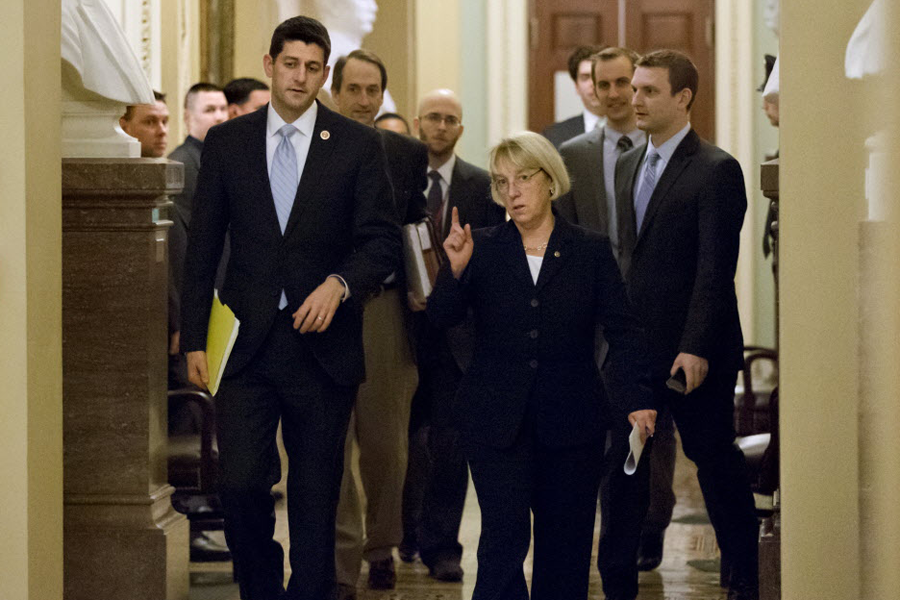Budget deal seen as boon to Pentagon. So why wouldn't veterans be happy?
Loading...
| Washington
The budget deal released to much fanfare at a Capitol Hill press conference this week, if approved, would allow the Pentagon to breathe a sigh of relief, since it would side-step the most dire of the threatened across-the-board cuts to its bottom line.
The proposed deal, widely considered a victory – if a modest one – for defense hawks, would also allow the Pentagon to kick some tough choices about strategic spending down the road.
“Politically, the Pentagon has won the skirmish. They’ve managed to hold off the next round of cuts,” says William Hartung, Director of the Arms & Security Project at the Center for International Policy.
At the same time, though, the deal is likely to anger veterans groups, who note that military retirees – and future retirees – will see their cost of living allowance (COLA) shrink in their retirement pay.
Under the proposed budget deal, the annual cost-of-living adjustment for working age military retirees would be inflation minus one percent.
“This will have a disastrous, long-term impact on the benefits already earned by those who have sacrificed so much,” notes Carlisle Williams, press secretary for Iraq and Afghanistan Veterans of America (IAVA).
But pull those provisions for a reduced COLA out, and the whole deal “starts to fall apart,” says Todd Harrison, senior fellow in Defense Budget Studies at the Center for Strategic and Budgetary Assessments, since the cuts “are big savings for the overall federal budget.”
Growing military personnel costs are a source of considerable concern for Pentagon officials as well as lawmakers, who argue that it is fair to ask military retirees to shoulder some of the cuts, since civilian government employees – many of whom work for the Department of Defense – are being asked to do the same thing.
That said, although the Pentagon would be escaping the worst of the potential cuts, “I think the best way to describe it is ‘partial relief’ from sequester for 2014 and 2015,” Mr. Harrison says.
The sequester is the series of mandatory, across-the-board, 10 percent spending cuts – some $500 billion over 10 years – that were slated to go into effect should Congress not come to a budget deal.
In that case, the Pentagon budget could have been cut by $52 billion in fiscal year 2014 from Obama’s requested $527 billion to roughly $475 billion. But under the proposed budget deal, the Pentagon would receive $520.5 billion in 2014.
True, it is still less than the increase in spending that the Pentagon had sought. “So this is basically a ‘push’ for the DOD. They are getting the same level of funding as 2013,” Harrison says.
Yet that is something of an accomplishment in the current fiscal climate, he adds. “The new ‘increase’ is not getting a decrease.”
The budget deal is a particularly fortunate development for the Pentagon, because it essentially ignored the spending caps that would have been put in place if sequester had gone through, Harrison notes.
For that reason, “we haven’t yet seen the Pentagon’s thinking as to how they would reshape the military” given the current era of belt-tightening coupled with the coming US troop drawdown in Afghanistan.
Nevertheless there are still some indications from senior defense officials that tough choices are on the horizon. Defense Secretary Chuck Hagel has noted that the Pentagon will have to choose between a larger force that won’t see as much modernization and a smaller force with more modern equipment.
Given the drawdown in Afghanistan and the Pentagon’s clear aversion to large, troop-heavy interventions for the foreseeable future, analysts tend to agree that the DOD will go in the latter direction.
The next step will revolve around more public discussions of “where we should be fighting and what’s important enough to fight over,” says Mr. Hartung.
“Unless they do that soon, the Pentagon is going to have some serious management problems,” he adds, “many of which will be self-inflicted.”







